 W
WAnthony, John, and Eustathius are saints and martyrs of the Russian Orthodox Church. Their feast day is celebrated on April 14 in the horologion.
 W
WThe Cathedral School of Vilnius was a cathedral school attached to the Vilnius Cathedral. It is believed to be the earliest school in the Grand Duchy of Lithuania. For about a hundred years it was the only Catholic school in Vilnius. The cathedral school was merged with Vilnius Academy, established by the Jesuits in 1570.
 W
WThe Cathedral Square in Vilnius is the main square of the Vilnius Old Town, right in front of the neo-classical Vilnius Cathedral. It is a key location in city's public life, situated as it is at the crossing of the city's main streets and reflecting the city's diversity. Regularly held at this site are fairs and gatherings of townspeople, military parades, religious and official public events, attractions and large concerts, New Year’s salutes and exhibitions. It is not merely the most lively and important location in the city, but is also one of the most significant and widely known symbols of Lithuania.
 W
WNikolay Mikhailovich Chagin was a Russian architect active primarily in Vilnius and the Crimea. He took part in the Siege of Sevastopol and served as Vilno's main architect for 38 years. Chagin mastered the Byzantine Revival and several other revivalist styles, often blending them at will. His church buildings include:Nativity Cathedral, Riga Cathedral of the Theotokos, Vilnius St. Paraskeva Church, Vilnius St. Euphrosyne Church, Vilnius St. Catherine Church, Vilnius Bell tower of St. Anne's Church, Vilnius Jelgava Orthodox Cathedral St. Mary's Church, Grodno Church of the Resurrection, Foros The interiors of the Chersonesus Cathedral
 W
WThe coat of arms of Vilnius is the coat of arms of the city of Vilnius, Lithuania. It is also used as coat of arms of Vilnius city municipality. The modern version was created in 1991 by Arvydas Každailis, the same artist who drew the modern coat of arms of Lithuania. The design is based on the oldest seals of the Vilnius City Council dating back to the 14th century.
 W
WElektrit Radiotechnical Society was the largest privately owned company in Wilno, Second Republic of Poland (1925–39).
 W
WThe Fareynikte Partizaner Organizatsye was a Jewish resistance organization based in the Vilna Ghetto that organized armed resistance against the Nazis during World War II. The clandestine organisation was established by Communist and Zionist partisans. Their leaders were writer Abba Kovner, Josef Glazman and Yitzhak Wittenberg.
 W
WFranciscan martyrs of Vilnius are 14 semi-legendary Franciscan friars murdered in Vilnius, capital of the Grand Duchy of Lithuania, during the reign of Algirdas (1345–77). The story was first recorded in the Bychowiec Chronicle, a generally unreliable source from the early 16th century, and was further embellished, conflated, and confused by later chroniclers and historians. Nonetheless, the cult of the martyrs spread in the 16th century. A prominent monument in Vilnius, the Three Crosses, was originally erected in their memory sometime before 1648. Around the same time Bishop Jerzy Tyszkiewicz started canonization procedures, but they were abandoned. At the advent of critical historiography in the 20th century, the story was dismissed as fictional in its entirety. However, newer research attempts to restore some credibility to the legend.
 W
WAbram Petrovich Gannibal, also Hannibal or Ganibal, or Abram Hannibal or Abram Petrov, was a Russian military engineer, general, and nobleman of African origin. Kidnapped as a child, Gannibal was taken to Russia and presented as a gift to Peter the Great, where he was freed, adopted and raised in the Emperor's court household as his godson.
 W
WElijah ben Solomon Zalman, known as the Vilna Gaon or Elijah of Vilna, or by his Hebrew acronym HaGra or Elijah Ben Solomon Zalman, was a Talmudist, halakhist, kabbalist, and the foremost leader of misnagdic (non-hasidic) Jewry of the past few centuries. He is commonly referred to in Hebrew as ha-Gaon he-Chasid mi-Vilna, "the pious genius from Vilnius".
 W
WThe Great Seimas of Vilnius was a major assembly held on December 4 and 5, 1905 in Vilnius, Lithuania, then part of the Russian Empire, largely inspired by the Russian Revolution of 1905. It was the first modern national congress in Lithuania and dealt primarily not with the social issues that sparked the revolution, but with national concerns. Over 2,000 participants took part in the Seimas. The assembly made the decision to demand wide political autonomy within the Russian Empire and achieve this by peaceful means. It is considered an important step towards the Act of Independence of Lithuania, adopted on February 16, 1918 by the Council of Lithuania, as the Seimas laid the groundwork for the establishment of an independent Lithuanian state.
 W
WHKP 562 was the site of a Nazi forced labor camp for Jews in Vilnius, Lithuania, during the Holocaust. Located at 47 & 49 Subačiaus Street, in apartment buildings originally built to house poor members of the Jewish community, the camp was used by the German army as a slave labor camp from September 1943 until July 1944. During that interval, the camp was officially owned and administered by the SS, but run on a day-to-day basis by a Wehrmacht engineering unit, Heereskraftfahrpark (HKP) 562, stationed in Vilnius. HKP 562's commanding officer, Major Karl Plagge, was sympathetic to the plight of his Jewish workers. Plagge and some of his men made efforts to protect the Jews of the camp from the murderous intent of the SS. It was partially due to the covert resistance to the Nazi policy of genocide toward the Jews by members of the HKP 562 engineering unit that over 250 Jewish men, women and children survived the final liquidation of the camp in July 1944, the single largest group of Jewish survivors of the Holocaust in Vilnius.
 W
WThe Iron Wolf is a mythical character from a medieval legend of the founding of Vilnius, the capital city of the old Grand Duchy of Lithuania and modern Republic of Lithuania. First found in the Lithuanian Chronicles, the legend shares certain similarities with the Capitoline Wolf and possibly reflected Lithuanian desire to showcase their legendary origins from the Roman Empire. The legend became popular during the era of Romantic nationalism. Today Iron Wolf is one of the symbols of Vilnius and is used by sports teams, Lithuanian military, scouting organizations, and others.
 W
WThe January Events took place in Lithuania between 11 and 13 January 1991 in the aftermath of the Act of the Re-Establishment of the State of Lithuania. As a result of Soviet military actions, 14 civilians were killed and 702 were injured. The events were centered in its capital, Vilnius, along with related actions in its suburbs and in the cities of Alytus, Šiauliai, Varėna, and Kaunas.
 W
WThe Józef Zawadzki printing shop was a family-owned printing shop operating in Vilnius from 1805 to 1939. It was established by Józef Zawadzki who took over the failing printing press of Vilnius University established in 1575. It was one of the largest and most prominent printing presses in Vilnius. Until 1828, it had the exclusive rights to publish university publications. It published numerous books and periodicals in Polish, Latin, Lithuanian. It suffered difficulties due to Russification policies that closed Vilnius University in 1832 and banned Lithuanian press in 1864, but recovered after the restrictions were lifted due to the Russian Revolution of 1905. After World War I, it had difficulty competing with the larger printing presses in Poland. The press was sold to a Lithuanian company Spindulys in 1939 and nationalized by the Lithuanian Soviet Socialist Republic in 1940. After World War II, the press was transferred to the communist daily Tiesa.
 W
WKailis forced labor camp was a Nazi labor camp for Jews in Vilnius during World War II. It was based on a pre-war fur and leather factory and mostly produced winter clothing for the German military. At its peak, after the liquidation of the Vilna Ghetto in September 1943, the camp housed about 1,500 Jews. The camp was liquidated and its workers executed at Ponary on 3 July 1944, just ten days before Red Army captured the city.
 W
WThere are 6 surviving transcripts of letters of Gediminas written in 1323–1324 by Grand Duke Gediminas. These letters are one of the first surviving documents from the Grand Duchy of Lithuania. Since they were sent to the Western Europe, the pope, merchants, and craftspeople, they were written in Latin.
 W
WLithuania District was an administrative division of German-controlled territory of Ober-Ost during World War I. It was bordered by the Bialystok-Grodno District to the south and the Courland District to the north.
 W
WThe Lithuanian Art Society was a society that organized Lithuanian art exhibitions and supported Lithuanian artists. Based in Vilnius, it was active from 1907 to the outbreak of World War I in 1914. It was chaired by painter Antanas Žmuidzinavičius. The society was established after the first Lithuanian art exhibition was successfully organized in early 1907. The society continued to organize annual exhibitions that displayed works both by professional and folk artists. Influenced by the Arts and Crafts movement, the society paid great attention to Lithuanian folk art which was increasingly seen as an expression of the Lithuanian character. In 1912, the society published an album of drawings of Lithuanian crosses, column shrines, and roofed pillars – it is considered the first study of Lithuanian folk art. The society was also instrumental in preserving art of Mikalojus Konstantinas Čiurlionis and organized his first solo exhibitions in 1911 and 1913. The society also collected works by other artists and worked with the Lithuanian Scientific Society to establish a Lithuanian art museum. The collection was transferred to the present-day M. K. Čiurlionis National Art Museum in 1920.
 W
WThe Museum of Antiquities in Vilnius was a museum of archaeology and history established by Count Eustachy Tyszkiewicz in 1855 at the premises of the closed Vilnius University. It was the first public museum in the former Grand Duchy of Lithuania and is considered a predecessor of the National Museum of Lithuania even though only a handful of items from the Museum of Antiquities ended up at the National Museum. Together with the Archaeological Commission which functioned as a de facto learned society, the museum was the most prominent cultural and scientific institution in all of Lithuania and displayed many historical items that reminded of the old Grand Duchy and served romantic nationalism of Lithuanian nobles at the time when Lithuania was part of the Russian Empire. The museum collections rapidly grew to over 67,000 items in 1865 by absorbing large collections of minerals and zoological specimens from the closed Vilnius University, libraries of various closed Catholic churches and monasteries, and various donations from local nobles.
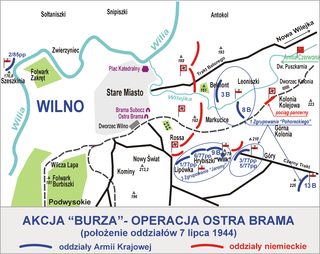 W
WOperation Ostra Brama was an attempt by the Polish Home Army to take over Vilnius from Nazi Germany's evacuating troops ahead of the approaching Soviet Vilnius Offensive. A part of a Polish national uprising, Operation Tempest, the action began on 7 July 1944 and lasted until 14 July 1944.
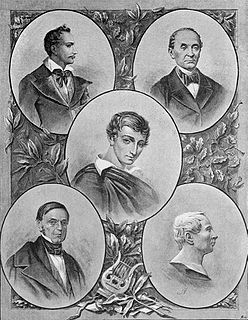 W
WThe Philomaths, or Philomath Society, was a secret student organization that existed from 1817 to 1823 at the Imperial University of Vilnius.
 W
WThe Ponary massacre or Paneriai massacre was the mass murder of up to 100,000 people, mostly Jews, Poles, and Russians by German SD and SS and their Lithuanian collaborators, including Ypatingasis būrys killing squads, during World War II and the Holocaust in Reichskommissariat Ostland. The murders took place between July 1941 and August 1944 near the railway station at Ponary, a suburb of today's Vilnius, Lithuania. Some 70,000 Jews were murdered at Ponary, along with up to 20,000 Poles, and 8,000 Russian POWs, most of them from nearby Vilna (Vilnius), and its newly-formed Vilna Ghetto.
 W
WPope Francis visited the Baltic states—Lithuania, Latvia, and Estonia—from 22 to 25 September 2018.
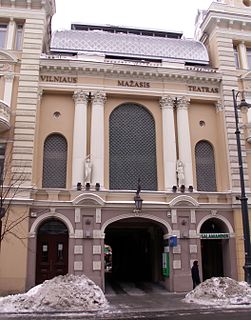 W
WRūta Society was a Lithuanian cultural society in Vilnius, then part of the Russian Empire, active from 1909 to the outbreak of World War I in 1914. It organized various events, including lectures, literary evenings, and musical performances, but it is most noted for its contribution to the development of the Lithuanian theater. In total, Rūta staged about 50 plays.
 W
WŠventaragis' Valley is a valley at the confluence of Neris and Vilnia Rivers in Vilnius, Lithuania. According to a legend recorded in the Lithuanian Chronicles, it was where Lithuanian rulers were cremated before the Christianization of Lithuania in 1387. Maciej Stryjkowski further recorded that it was the location of a pagan temple dedicated to Perkūnas, the god of thunder. While the legends are generally dismissed as fiction by historians, they been studied and analyzed from the perspective of pagan Lithuanian mythology by Vladimir Toporov, Gintaras Beresnevičius, Norbertas Vėlius, Vykintas Vaitkevičius, and others.
 W
WTuskulėnai Manor is a neoclassical manor in Žirmūnai elderate of Vilnius, Lithuania. It is best known as burial grounds of people executed by the KGB in 1944–1947. After Lithuania regained independence in 1990, the manor was reconstructed and the park was transformed into a memorial to the victims of Soviet repressions. It is administered by the Lithuanian Genocide and Resistance Research Center.
 W
WThe Vilna Edition of the Talmud, printed in Vilna, Lithuania, is by far the most common printed edition of the Talmud still in use today as the basic text for Torah study in yeshivas and by all scholars of Judaism.
 W
WThe Vilna Ghetto was a World War II Jewish ghetto established and operated by Nazi Germany in the city of Vilnius in the territory of Nazi-administered Reichskommissariat Ostland.
 W
WThe Vilna Governorate or Government of Vilnius was a governorate of the Russian Empire created after the Third Partition of the Polish–Lithuanian Commonwealth in 1795. It was part of the Lithuanian General Governorate, which was called the Vilnius General Governorate after 1830, and was attached to the Northwestern Krai. The seat was in Vilnius, where the Governors General resided.
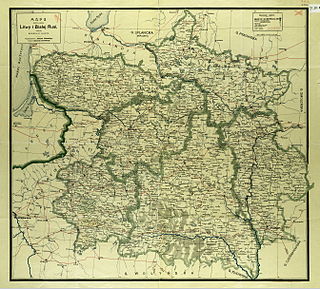 W
WVilna Governorate-General, known as Lithuania Governorate-General before 1830, was a Governorate-General of the Russian Empire from 1794 to 1912. It primarily encompassed the Vilna, Grodno, and Kovno Governorates. Governors General were also commanders of the Vilna Military District. According to the Russian Empire Census, the Governorate-General had 4,754,000 residents in 1897.
 W
WThe Vilna Group was a circle of Jewish Social-Democrats which met secretly in the city of Vilna, then part of the Russian empire. The group was founded in the mid-1890s. Its members devoted themselves to disseminating Marxist and socialist literature to Jewish textile workers and to some extent to Jewish and non-Jewish workers generally, providing literacy and education classes for workers and supporting the formation of trade unions. They were among the first to produce socialist literature in Yiddish. All this was illegal and had to be done clandestinely, and all members of the Vilna Group were arrested at various points. The Vilna group included, among others, Arkadi Kremer and his wife Pati Kremer, John Mill and Mikhail Liber. It was one of the precursors of the General Jewish Workers' Association in Lithuania, Poland and Russia, founded in 1897. The Vilna Group also played a role in founding the Russian Social-Democratic Workers' Party (RSDRP) in 1898. Most veterans of the Vilna Group later supported the Mensheviks.
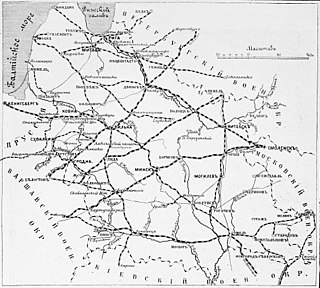 W
WVilna Military District was a military district of the Imperial Russian Army. The district was formed in 1862 as part of Russian military reforms and was responsible for parts of modern Belarus, Latvia, Lithuania, and Poland. The district was disbanded at the beginning of the First World War in July 1914, and its headquarters were used to form another district farther to the rear.
 W
WThe Vilna offensive was a campaign of the Polish–Soviet War of 1919–1921. The Polish army launched an offensive on April 16, 1919, to take Vilnius from the Red Army. After three days of street fighting from April 19–21, the city was captured by Polish forces, causing the Red Army to retreat. During the offensive, the Poles also succeeded in securing the nearby cities of Lida, Pinsk, Navahrudak, and Baranovichi.
 W
WVilnian National Guard was a paramilitary unit formed in the city of Vilna during the French invasion of Russia in 1812. Among the duties of the unit were maintaining law and order in the city, but also guarding state and military buildings. The Vilnian National Guard took part in the Battle of Vilna later that year, during Napoleon's retreat from Russia. Following the Russian take-over of the city the Guard was disbanded.
 W
WThe Battle of Wilno was fought by the Polish Army against the Soviet invasion of Poland in 1939, which accompanied the German Invasion of Poland in accordance with Molotov–Ribbentrop Pact. On 18–19 September, Soviet forces took over the city of Wilno. Polish forces, concentrated in the west, were relatively weak in the east. The Polish commanders, unsure whether to actively oppose the Soviet entry into Poland, did not use the full defensive capabilities of the town and nearby fortifications, although the outcome of the battle would not have been likely any different, given the overwhelming Soviet numerical superiority.
 W
WThe Vilnius Castle Complex is a group of cultural, and historic structures on the left bank of the Neris River, near its confluence with the Vilnia River, in Vilnius, Lithuania. The buildings, which evolved between the 10th and 18th centuries, were one of Lithuania's major defensive structures.
 W
WThe Vilnius Group was an organization of NATO aspirant countries, created in May 2000, aimed at practical cooperation, exchange of information and lobbying for their candidacy in the NATO capitals.
 W
WVilnius Land Bank was the first bank established in Vilnius, present-day Lithuania. It was a private joint-stock mortgage bank serving the Northwestern Krai of the Russian Empire. Its mission was to provide loans collateralized by real estate to manor owners (agriculture) and city residents (industry). As it could not accept deposits, the bank issued mortgage bonds to raise funds for the loans. The bank was established in 1872 after a banking reform. It was one of eleven land banks operating in the Empire, and grew to be one of the largest. Despite several economic crises, particularly the one caused by the Russian Revolution of 1905, the outstanding loans grew from 5 million rubles in 1874 to 148.8 million in 1912. Both Lithuanians and Russians complained that the bank was controlled by and served the Polish interests. During World War I, the bank was evacuated to Petrograd. After the war, in 1920, it returned to Vilnius, which became part of the Second Polish Republic. It continued to operate at diminished volumes until the Soviet invasion of Poland in 1939.
 W
WVilnius Military School also known as the Vilnius Junker Infantry School was a military school for the non-commissioned officers (NCO) and junior officers of the Imperial Russian Army that operated in 1864–1915 in Vilnius. Up to 1910, the school prepared 4,371 podpraporshchiks and junior officers. During World War I, it relocated to Poltava and operated there in 1915–1918. In total, about 10,500 men graduated from the school, many becoming prominent military leaders and commanders in the post-war Eastern Europe.
 W
WThe Wilno school massacre was a school shooting that occurred on 6 May 1925 at the Joachim Lelewel High School in Wilno, Poland. During the final exams, at about 11 a.m., at least two eighth-grade students attacked the board of examiners with revolvers and hand grenades, killing two students, one teacher, and themselves.
 W
WThe Vilnius Uprising of 1794 began on April 22, 1794, during which Polish and Lithuanian forces led by Jakub Jasiński fought Russian forces occupying the city during the Kościuszko Uprising. The Russians were expelled from Vilnius, and thanks to Jasiński's skill, no casualties were sustained during the bloodless uprising. Vilnius townspeople also actively participated in the city's defense from the Russians, some even by throwing stones at them.
 W
WThe Vilnius city wall was a defensive wall around Vilnius, capital city of the Grand Duchy of Lithuania. It was built between 1503 and 1522 for protection from the attacks by the Crimean Khanate at the beginning of the Muscovite–Lithuanian Wars. The stone and brick wall was a key element of the defensive system of Vilnius, and was paid for by the city's landowners. It contained nine gates and an artillery bastion. Some of the original constructions have survived.Subačius Gate was built at the end of what is now Holly Spirit street. Spas Gate was built near the Vilnia River in the eastern side of city. Wet Gate stood near Cathedral Square in Vilnius. Tatar Gate stood at the corner of Liejykla and Totoriai street. Vilija Gate stood at the corner of Vilnius and Bernardinai street. Trakai Gate was built at the corner of Trakai and Pylimas streets. It was the main gate of the city and contained a chapel. Rūdininkai Gate stood at the end of the Rūdininkai street. Medininkai Gate guarded the entrance to the southern part of the city. It is now known as the Gate of Dawn.
 W
WThe Wilno Voivodeship was one of 16 Voivodeships in the Second Polish Republic, with the capital in Wilno. It was created in 1926 and populated predominantly by Poles with notable minorities of Belarusians, Jews and Lithuanians.
 W
WŽirmūnai (pronounced [ʑɪrˈmuːnɐi] is the most populous administrative division in Vilnius. It is also a neighbourhood in the Lithuanian capital city Vilnius, encompassing the city district of the same name, built in the 1960s.